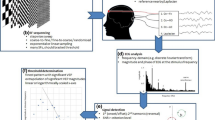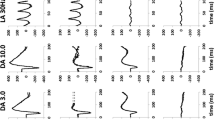Abstract
To optimize the simultaneous recording of retinal and cortical potentials, we tried to identify the most sensitive condition for pattern-electroretinogram (PERG) and pattern visual evoked potential (VEP) concerning the temporal frequency. In the same session PERGs and VEPs were elicited by checkerboard patterns with 5 temporal frequencies ranging from 8 rps to 33 rps. For data analysis the steady-state responses were Fourier analysed. We evaluated whether a statistically significant response was present, estimated the magnitude of the response at the stimulus frequencies tested and estimated it's significance. For PERG less dependence on temporal frequency was evident compared to VEP. The magnitude of the VEP response was larger than that of the PERG. However the rate of statistically significant responses for the PERG compared to that of the VEP was similar for the small checksize and even higher for the large checksize. The results permit a simultaneous recording in the range of temporal frequencies, where high responses are acquired from both levels, retinal and cortical.
Similar content being viewed by others
References
Adachi-Usami E, Hosoda L, Toyonaga N. Effects of aging on the temporal frequency characteristics determined by pattern visually evoked cortical potentials. Doc Ophthalmol 1988; 69(2): 139–44.
Bach M, Hawlina M, Holder GE., Marmor MF, Meigen T, Vaegan Miyake Y. Standard for pattern electroretinography. International society for clinical electrophysiology of vision. Doc Ophthalmol 2000; 101(1): 11–8.
Bach M, Meigen T, Strasburger H. Raster-scan cathode-ray tubes for vision research-limits of resolution in space, time and intensity, and some solutions. Spat Vis 1997; 10(4): 403–14.
Bach M, Waltenspiel S, Bühler B, Röver J. Sehbahndiagnos-tik mit simultanter Registrierung der retinalen und kortikalen Musterpotentiale. Fortschr Ophthalmol 1985; 82(4): 398–401.
Burkitt GR, Silberstein RB, Cadusch PJ, Wood AW. Steady-state visual evoked potentials and travelling waves '. Clin Neu-rophysiol 2000; 111(2): 246–58.
Celesia GG, Kaufman D, Cone S. Effects of age and sex on pattern electroretinograms and visual evoked potentials. Electroencephalogr Clin Neurophysiol 1987; 68(3): 161–71.
Fagan JE, Downard J, FG, Yolton RL. Steady-state visual evoked response amplitudes and concurrent electroencephalographic activity. Am J Optom Physiol Opt 1985; 62(6): 418–22.
Fiorentini A, Trimarchi C. Development of temporal properties of pattern electroretinogram and visual evoked potentials in infants. Vision Res 1992; 32(9): 1609–21.
Groneberg A, Teping C. Topodiagnostik von Sehstörungen durch Ableitung retinaler und kortikaler Antworten auf Umkehr-Kontrastmuster. Ber Dtsch Ophthalmol Ges 1980; 77: 409–17.
Hajek A, Zrenner E, Verbesserte objektive Visusprüfung mit visuell evozierten corticalen Potentialen durch schnelle Reizmustersequenzen unterschiedlicher Raumfrequenz. Fortschr Ophthalmol 1988; 85: 550–4.
Harding GF, Odom JV, Spileers W, Spekreijse H. Standard for visual evoked potentials 1995. The International Society for Clinical Electrophysiology of Vision. Vision Res 1996; 36(21): 3567–72.
Heine S, Rüther K, Isensee J, Zrenner E. Clinical significance of objective vision assessment using visually evoked cortical potentials induced by rapid pattern sequences of different spatial frequency. Klin Monatsbl Augenheilkd 1999; 215(3): 175–81.
Holder GE. The pattern electroretinogram in anterior visual pathway dysfunction and its relationship to the pattern visual evoked potential: a personal clinical review of 743eyes. Eye 11(Pt 6): 924–34.
Holder GE. Pattern electroretinography (PERG)and an inte-grated approach to visual pathway diagnosis. Prog Retin Eye Res 2001; 20(4): 531–61.
Justino L, Kergoat H, Kergoat MJ. Changes in the retinocortical evoked potentials in subjects 75 years of age and older '. Clin Neurophysiol 2001; 112(7): 1343–8.
Kaufman D, Celesia GG. Simultaneous recording of pat-tern electroretinogram and visual evoked responses in neuro-ophthalmologic disorders. Neurology 1985; 35(5): 644–51.
Maffei L, Fiorentini A. Generator sources of the pattern ERG in man and animals. Evoked Potentials. Frontiers of Clinical Neuroscience 1986; 3: 101–16.
Mast J, Victor JD. Fluctuations of steady-state VEPs: inter-action of driven evoked potentials and the EEG. Electroencephalogr Clin Neurophysiol 1991; 78(5): 389–401.
Matsui Y, Saito I, Okinami S, Oono S. Influence of simultaneous pattern-reversal electroretinogram recording on visual evoked potentials. Doc Ophthalmol 1994; 86(3): 285–94.
Meigen T, Bach M. On the statistical significance of electro-physiological steady-state responses. Doc Ophthalmol 1999; 98(3): 207–32.
Moskowitz A, Sokol S. Spatial and temporal interaction of pattern-evoked cortical potentials in human infants. Vision Res 1980; 20(8): 699–707.
Nakamura A, Akio T, Matsuda E, Wakami Y. Pattern visual evoked potentials in malingering. J Neuroophthalmol 2001; 21(1): 42–5.
Norcia AM, Tyler CW. Infant VEP acuity measurements: anal-ysis of individual differences and measurement error. Electroencephalogr Clin Neurophysicol 1985a; 61(5): 359–69.
Norcia AM, Tyler CW. Spatial frequency sweep VEP: visual acuity during the first year of life. Vision Res 1985b; 25(10): 1399–1408.
Parry NR, Murray IJ, Hadjizenonos C. Spatio-temporal tuning of VEPs:effect of mode of stimulation. Vision Res 1999; 39(21): 3491–7.
Petersen J. Objective determination of viusal acuity by visual evoked potentials. Dev Ophthal 1984; 9: 108–14.
Pigeau RA, Frame AM. Steady-state visual evoked responses in high and low alpha subjects. Electroencephalogr Clin Neurophysiol 1992; 84(2): 101–9.
Porciatti V, Burr DC, Morrone MC, Fiorentini A. The effects of aging on the pattern electroretinogram and visual evoked potential in humans. Vision Res 1992; 32(7): 1199–209.
Regan D. Steady-state evoked potentials. J Opt Soc Am 1977; 67(11): 1475–89.
Regan D. Assessment of visual acuity by evoked potential recording:ambiguity caused by temporal dependence of spatial frequency selectivity. Vision Res 1978; 18(4): 439–43.
Rimmer S, Iragui V, Klauber MR, Katz B. Retinocortical time exhibits spatial selectivity. Invest Ophthalmol Vis Sci 1989; 30(9): 2045–9.
Sokol S, Jones K, Nadler D. Comparison of the spatial response properties of the human retina and cortex as measured by simultaneously recorded pattern ERGs and VEPs. Vision Res 1983; 23(7): 723–7.
Teping C. Determination of visual acuity by the visually evoked cortical potential. Klin Monatsbl Augenheilkd 1981; 179(3): 169–72.
Tyler CW, Apkarian P, Levi DM, Nakayama K. Rapid assess-ment of visual function: an electronic sweep technique for the pattern visual evoked potential. Invest Ophthalmol Vis Sci 1979; 18(7): 703–13.
Tyler CW, Nakayama K, Apkarian PA, Levi D.M. VEP assessment of visual function. Vision Res 1981; 21(4): 607–9.
Zapf HR, Bach M. The contrast characteristic of the pat-tern electroretinogram depends on temporal frequency. Graefes Arch Clin Exp Ophthalmol 1999; 237(2);93–9.
Author information
Authors and Affiliations
Rights and permissions
About this article
Cite this article
Heine, M., Meigen, T. The dependency of simultaneously recorded retinal and cortical potentials on temporal frequency. Doc Ophthalmol 108, 1–8 (2004). https://doi.org/10.1023/B:DOOP.0000018367.29985.98
Issue Date:
DOI: https://doi.org/10.1023/B:DOOP.0000018367.29985.98




